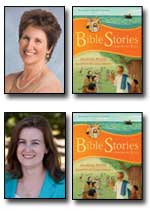New York Times bestselling author Francine Rivers and her daughter Shannon Rivers Coibion used the "divide and conquer" approach when they set about writing BIBLE STORIES FOR GROWING KIDS. What motivated them to write this type of book and what did they learn?
 What made you decide to write together?
What made you decide to write together?
Francine: I had been working on novels on men and women in the Bible and thought it would be fun to work with my daughter on a book aimed at young children – something that could be useful for families to teach and encourage critical thinking at a young age. As a homeschooling Mom, Shannon would have more insights into what is needed, and, of course, I was hoping she would be bitten by the writing bug and want to continue with other projects on her own.
Shannon: I had been struggling to find a devotional to use with my children each morning, so when Mom and I decided to do Bible Stories, I had that in mind. We wrote the book for kids around Brendan and Andrea’s age, with stories straight out of the Bible and questions to get them interesting in reading the Bible for themselves.
Can you each share a story about one of the books you wrote together?
Both: We only wrote one book together: Bible Stories for Growing Kids. What began as a simple project developed into a far bigger, more involved and complex project. We had at first thought of doing short-short stories and a few questions.
How do you share your writing responsibilities?
Francine: We divided the writing responsibilities. I took on the task of writing thirty biblical fiction stories about people from the Bible – men, women, both good and bad.
Shannon: I wrote the “Growing Time” sections. It’s intended to help children look deeper into the Bible.
Who has final say? Does “Mom always rule”, or how do you handle writing conflicts?
Francine: In this project, an experienced editor “ruled” – though I wouldn’t put it that strongly. Betty Swanburg has been involved in children’s projects for years and knew what needed to be done. She was teacher, editor and advocate. There is so much to learn about language, form and content in regard to writing for children. And my vision was to complete a project that could be used as a family devotional, something parents could read with their children and use to encourage critical thinking.
Shannon: I looked to my mom for how to get the work done. She’s obviously got the experience, so it was nice to be able to ask what to do when I felt like I hit a wall, or if I wanted a sounding board.
What do each of you bring to the table?
Francine: I brought 30 years of writing fiction to the table, though a novel is a far different thing than writing short stories. That proved a great challenge to me.
Shannon: What I brought was fresh perspective and youthful enthusiasm. J Really, I always have a lot of questions, so the “Growing Time” section was really what I wanted to do. It was fun to ask my kids for help instead of the other way around! If they didn’t understand what I was asking, it didn’t go in the book.
What’s your favorite snack food/drink when you are writing?
Francine: A glass of milk and a tin of Pringles! Or coffee and a bag of Trail Mix with yogurt covered cranberries.
Shannon: Coffee, coffee, coffee!!!
Do you have advice for anyone who would like to write a book with their mother or daughter?
Francine: Have a shared vision of what you want to accomplish with your book. Brain-storm together. Expect to learn from one another! Respect boundaries. Above all,
enjoy yourselves!
Shannon: Be willing to accept constructive criticism, and be willing to laugh at your own mistakes. Also, one of the things my mom has always taught me is to “say it with love”. And make sure you’re both on the same page --- pun intended.
 What made you decide to write together?
What made you decide to write together?
